
Hire someone with proven research skills to translate your sensitive documents
After receiving my PhD in Ecology, Evolution, and Systematics from the University of Missouri–St. Louis, I decided to leave academia to become a full-time translator and pursue my passion for languages. In 2016, I completed the Certificate in English to Portuguese Translation from New York University, and in 2017 I became certified as an English to Portuguese translator by the American Translators Association.
I strive to write technically precise and well-written text, and I have a knack for hunting down the appropriate translation of even the most specialized terms. I do not translate word-for-word, but rather write a text that flows well in the target (translated) language, while maintaining the meaning of the source. I specialize in scientific texts, and I use corpora extensively to ensure natural-sounding target texts.
Qualifications
I am a PhD in Biology and certified by the American Translators Association as a translator in the English to Portuguese pair
■ Native Brazilian Portuguese speaker who has been living in the U.S. for over 12 years
■ Experience translating and editing medical and scientific documents
■ Member of ATA (American Translators Association) and NCATA (National Capital Area Translators Association)
TRANSLATOR TRAINING
Certificate in English to Portuguese Translation from New York University (2016). Courses include English to Portuguese Medical Translation, English to Portuguese Legal Translation, English to Portuguese Translating the News, Introduction to CAT andTerminology Management and Subtitling and Voice Replacement for Translators
SOFTWARE
SDL Trados Studio 2019
MemoQ 9.4
CafeTran Espresso
XTM
OmegaT
SDL MultiTerm 2019
SynchroTerm
EXPERIENCE
Six years of experience translating and back-translating clinical trial resource guides, medical case reports, investigational medicinal product dossiers, medication labels, patient brochures, grant reports, news items, and scientific manuscripts on Botany, Ecology, Forestry, Zoology, Pharmacology, Phytochemistry, and Molecular Biology.
VOLUNTEERING
Volunteer translations of Coursera video lessons and of written documents for non-profits through the Rosetta Foundation
Recent professional development activities
– Rodada de Palestras sobre Sistemas de Saúde (Lecture Series on Healthcare Systems), online, Jun 21-25, 2021
– Into-English Patent Translation, online, Jan-Feb 2021
– ATA Mastermind group on CAT tools, online, Feb-Jul 2021
– Documentos médicos: características e aspectos jurídicos e éticos (Medical Documents: Characteristics and Legal and Ethical Aspects), online, Jul 18 and 25, 2020

Say Hello
Use this form to send me an email, I’ll reply as soon as I can